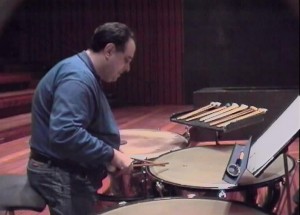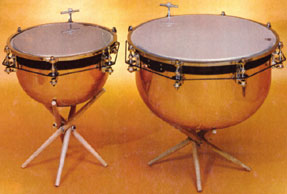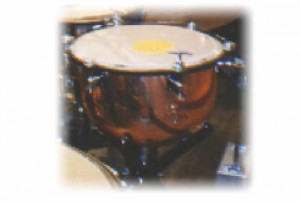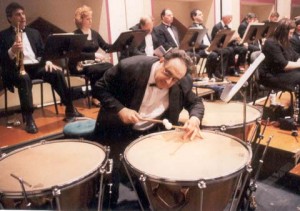The Timpani
Most musicians know what the timpani are, and so do many people, but I still get questions from quite a few, especially from those who are not familiar with classical music and young people who have not had exposure to the instruments of the orchestra. So, that being the case, I think that it is a good idea to devote this post to a description of what the instruments are. What follows is from a short presentation that I had posted to a previous, but no longer extant web site. The information is still valid and it is my hope that it will provide you with a better idea of just what the timpani are and how they work.
The Timpani
A Short History
The timpani have been around for centuries. Descended from a small pair of drums called “nakers”, they developed over time into the instruments we know today as the orchestral timpani. They were brought to western Europe by King Henry VIII of England, who used them mounted on horseback for ceremonial occasions. Together with trumpets, they added much color to the various ceremonials associated with the monarchy. Eventually, the drums found place in the various court orchestras (no longer mounted on horseback), but still used together with trumpets.
The music of the great Baroque composers J. S. Bach and G. F. Handel is full of this type of writing for the instruments.
With the music of W.A. Mozart, F. J. Haydn and L. van Beethoven, things began to change with regard to composing for the timpani. Up until this time, the timpani were tuned in the interval of a fourth or fifth. Beethoven was an innovator in this respect as he scored for the timpani in octaves (F-f) in his Eighth and Ninth Symphonies, and a tritone (A-e-flat) in his opera “Fidelio”. Other composers, such as Weber,
Mendelssohn, Brahms, Schumann, and Liszt, to name only a few began to write interesting parts for the timpani, but it was the music of such composers as Berlioz, Wagner, Bruckner,
Mahler, and Richard Strauss that really helped to make the timpani an integral part of the orchestra. Another factor to be considered in this regard was the development of machine-tuned timpani.
Up until the end of the nineteenth century, most drums were of the hand-tuned type. The invention of the pedal-tuned timpani enabled the composer to be much more creative in writing for the timpani. The twentieth century saw the rapid development of both the pedal-tuned timpani and the music of the century’s greatest composers, for example, Bartok, Stravinsky, Britten, Debussy, Ravel, Elgar, Sibelius, and Nielsen.
Nomenclature
The name timpani is actually the plural Italian name of the instrument. To find out what they are called in English, German, Spanish, French, etc., see below:
English: kettledrums (plural); kettledrum (singular)
German: pauken (plural): pauke (singular).
Italian:timpani (plural); timpano (singular)
Latin: tympani (plural); tympano (singular)
Spanish:timbales (plural); timbale (singular)
French:timbales (plural); timbale (singular)
In the United States, Canada and Britain, it has become the rule to use the Italian name for the instruments. The British even shorten that, calling the instruments “timps”.
Sizes and Ranges
For many years, the average set of timpani consisted of a pair of drums. These averaged in size from about 28 inches for the larger drum, to about 25 inches for the smaller. As composers became more comfortable with writing for the instrument (particularly after the advent of the pedal tuned timpani), an extra drum was added.
Today, the average set of timpani consists of either four or five drums. This is due to the many contemporary compositions which demand the use of four or more timpani. The sizes of the drums are as follows, starting with the largest: (NB!! Size varies according to manufacturer, although you can order almost any size you want!)
For those of you who are new to the world of timpani, the music for the instrument is written in the bass clef.
Size: 32 inch (or 31 inch). Range: Low D to A
Size: 29 inch (or 28 inch). Range: Low F to c sharp (or d)
Size: 26 inch (or 25 inch) Range: B flat to f (or f sharp)
Size: 23 inch (or 22 and 1/2) Range: d to a (or high b flat)
Size: 20 inch Range: f to high c
Up until a few years ago, the number of timpani varied, according to the type of ensemble. Junior High and Elementary
School bands used the basic pair of timpani, namely the 26 inch and 29 inch drums, adding the outside drums (either the 23 inch or the 32 inch) when they could afford to. High School Bands were more likely to have the two basic drums as well as at least one extra drum. Colleges and professional organizations always had at least the two basic drums plus the two outside drums. Nowadays, almost all high schools are equipped with four drums, and colleges and professional ensembles have the full set of five.

Demonstrating how to do the “ship’s engine’ effect from Variation XIII of Elgar’s “Enigma Variation”
This photograph was taken during a series of rehearsals of the Oslo Philharmonic Orchestra. The above musician was timpanist of that orchestra for 15 years, from 1983-1998. Here he is shown demonstrating the 13th variation (***) of Sir Edward Elgar’s “Enigma” Variation. In this variation, the composer asks the player to use snare drum sticks near the edge of the head to simulate the sound of a liner’s engines. The dynamic is pianissimo, and sticks always seemed too loud! Here, the player is trying a different approach: Sticks with a coin on the head! The drums being used are a 31 inch Light chain timpano, and a pair of Hinger timpani, sizes 28 inch and 25 inch.
Above are a pair of Light Continental Chain timpani. They are obviously the outer pair of timpani, most probably sizes 23 inch and 32 inch. I used a 31 inch Continental chain drum with calfskin during my years in Oslo, and it had plenty of projection.
23 inch Stotz-Anheier timpano made for the Oslo Philharmonic by Brian Stotz in 1994. The instrument had a very clear pitch, and was relatively easy to tune and maintain.
These drums have remarkable pitch and clarity. This set dates from ca. 1977 – 84.




Recent Comments